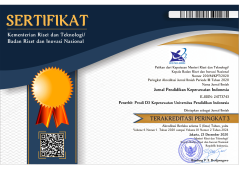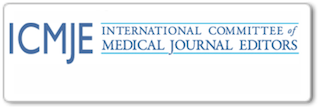Causative Factor of Low Birth Weight (LBW) Babies in Bandung City Hospital
Abstract
The LBW mortality rate reaches 15 to 20% in the world. the proportion of infant deaths originating from the age of 0-28 days (Neonatal) was 84.63% or 3.32/1000 live births and and body weight < 2500 grams reached 6.3%, while the proportion of babies born weighing < 2500 grams with body length < 48 cm in Indonesia reached 4.0% and in West Java reached 4.2%. The purpose of this study was to determine the factors that cause babies born with low birth weight. The type of research used by researchers is a descriptive survey research method using a retrospective study design using medical record register data for newborns who have been treated. The population in this study were all low-birth-weight babies in the last year at Bandung City Hospital, using secondary data at the medical record installation section in the last year as many as 543 babies. The sample in this study is secondary data from babies born with LBW as many as 85 respondents. The sampling technique is probability sampling using a random sampling method using register data from medical records. The analysis in this study uses univariate analysis to see the frequency distribution of each sub-variable. The results of the study occurred in multipara parity, namely 46 (54.1%), gestational age at risk, namely 47 (55.3%), maternal age at risk, namely 46 (54.1%), twin births, namely 19 (22.4%) of the 85 respondents, pregnancies without placenta previa were 77 (90.6%). The results of this study indicate that the factor of gestational age is the highest that causes LBW babies to be born. It is recommended that efforts be made to reduce the number of LBW babies born by optimizing preventive efforts, health workers are required to provide health education about the causes of LBW.
Keywords
Full Text:
PDFReferences
Agbozo, F., Abubakari, A., Der, J., & Jahn, A. (2016). Prevalence of low birth weight, macrosomia and stillbirth and their relationship to associated maternal risk factors in Hohoe Municipality, Ghana. Midwifery, 40, 200-206.
Alonso‐Ojembarrena, A., & Lubián‐López, S. P. (2019). Lung ultrasound score as early predictor of bronchopulmonary dysplasia in very low birth weight infants. Pediatric Pulmonology, 54(9), 1404-1409.
Darmawati, I., Marfuah, D., & Nurleli, L. (2023). Knowledge is Not Related to Iron Tablets Consumption Compliance in Pregnant Women. Jurnal Keperawatan Komprehensif (Comprehensive Nursing Journal), 9(2), 181-186.
Fall, C. H., Sachdev, H. S., Osmond, C., Restrepo-Mendez, M. C., Victora, C., Martorell, R., ... & Richter, L. M. (2015). Association between maternal age at childbirth and child and adult outcomes in the offspring: a prospective study in five low-income and middle-income countries (COHORTS collaboration). The Lancet Global Health, 3(7), e366-e377.
Goisis, A., Remes, H., Barclay, K., Martikainen, P., & Myrskylä, M. (2017). Advanced maternal age and the risk of low birth weight and preterm delivery: a within-family analysis using Finnish population registers. American journal of epidemiology, 186(11), 1219-1226.
Astuti, E. R. (2021). Factors Associated with The Incidence of Low Birth Weight. Journal of Health Science and Prevention, 5(2), 81-87.
Jumhati, S., & Noviati, D. (2018). Analysis of Factors Associated with LBW Incidence at Permata Cibubur-Bekasi Hospital. Journal of Public Health Sciences, 7(2).1-10.
Kenny, L. C., Lavender, T., McNamee, R., O’Neill, S. M., Mills, T., & Khashan, A. S. (2013). Advanced maternal age and adverse pregnancy outcome: evidence from a large contemporary cohort. PloS one, 8(2), e56583.1-9.
Mahdalena, S., Astuti, T., & Vitrianingsih, V. (2018). Faktor-Faktor Yang Berhubungan Dengan Kejadian BBLR Di RSUD Wonosari, Gunungkidul Tahun 2017. Jurnal Keperawatan Respati Yogyakarta, 5(2), 406-413.
Khan, W., Zaki, N., Masud, M. M., Ahmad, A., Ali, L., Ali, N., & Ahmed, L. A. (2022). Infant birth weight estimation and low birth weight classification in United Arab Emirates using machine learning algorithms. Scientific reports, 12(1), 12110.1-11.
Klemetti R., Gissler M., Sainio S., H. E. (2013)., ‘Associations of maternal age with maternity care use and birth outcomes in primiparous women: a comparison of results in 1991 and 2008 in Finland’, Acta Obstet Gynecol Scand,75, pp. 19–27. doi: https://doi.org/ 10.1111/1471-0528.12415. 121(3), 356-362.
Kusumawati, E. (2017). A systematic review againts risk factors on the low-weight birth incidence in Indonesia. Journal of Health Science and Prevention, 1(1), 38-44.
Lake, E. A., & Olana Fite, R. (2019). Low birth weight and its associated factors among newborns delivered at wolaita sodo university teaching and referral hospital, southern Ethiopia, 2018. International journal of pediatrics. 1(1), 1-7.
Mahayana, S. A. S., Chundrayetti, E., & Yulistini, Y. (2015). Faktor Risiko yang Berpengaruh terhadap Kejadian Berat Badan Lahir Rendah di RSUP Dr. M. Djamil Padang. Jurnal Kesehatan Andalas, 4(3). 664-673
Ngowa, J. D. K., Ngassam, A. N., Dohbit, J. S., Nzedjom, C., & Kasia, J. M. (2013). Pregnancy outcome at advanced maternal age in a group of African women in two teaching Hospitals in Yaounde, Cameroon. The Pan African Medical Journal, 14. 1-6
Ondusko, D. S., Liu, J., Hatch, B., Profit, J., & Carter, E. H. (2022). Associations between maternal residential rurality and maternal health, access to care, and very low birthweight infant outcomes. Journal of Perinatology, 42(12), 1592-1599.
Setiati, A. R., & Rahayu, S. R. S. (2017). Faktor yang mempengaruhi kejadian BBLR (Berat Badan Lahir Rendah) di ruang perawatan intensif neonatus RSUD dr Moewardi di Surakarta. (JKG) Jurnal Keperawatan Global, 2(1). 9-20
Vilanova, C. S., Hirakata, V. N., de Souza Buriol, V. C., Nunes, M., Goldani, M. Z., & da Silva, C. H. (2019). The relationship between the different low birth weight strata of newborns with infant mortality and the influence of the main health determinants in the extreme south of Brazil. Population health metrics, 17(1), 1-12.
Wahyuni, D., & Puspitasari, E. (2021). The Relationship Between Preeclampsia And Low Birth Weight (Lbw) In Wonosari, Gunungkidul Regional Hospital. Epidemiology and Society Health Review, 3(1), 1-7.
Wahyuningrum, T., Saudah, N., & Novitasari, W. W. (2015). Hubungan Paritas Dengan Berat Bayi Lahir Di Rumah Sakit Umum Daerah Dr. Wahidin Sudiro Husodo Mojokerto. Jurnal Kebidanan Midwiferia, 1(2), 87-92.
DOI: https://doi.org/10.17509/jpki.v9i1.55744
Refbacks
- There are currently no refbacks.
Jurnal Pendidikan Keperawatan Indonesia(JPKI) published by Indonesia University of Education. JPKI is licensed under a Creative Commons Attribution-ShareAlike 4.0 International License.
Office :
Nursing Department. FPOK UPI.
229, Dr. Setiabudhi Street. Bandung 40154
West Java , Indonesia
E-mail : jpki@upi.edu

_.png)
_.png)
_.png)











